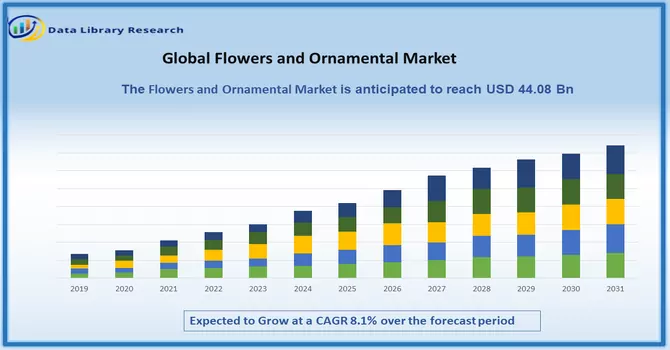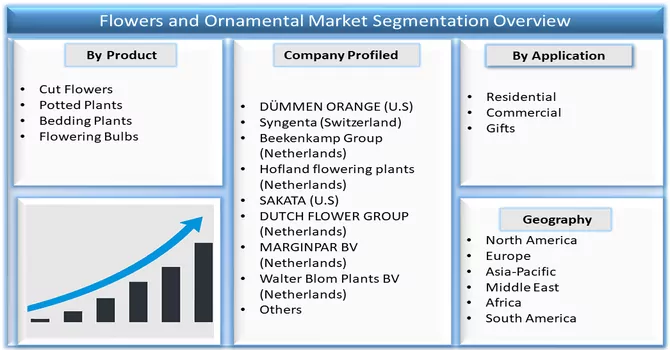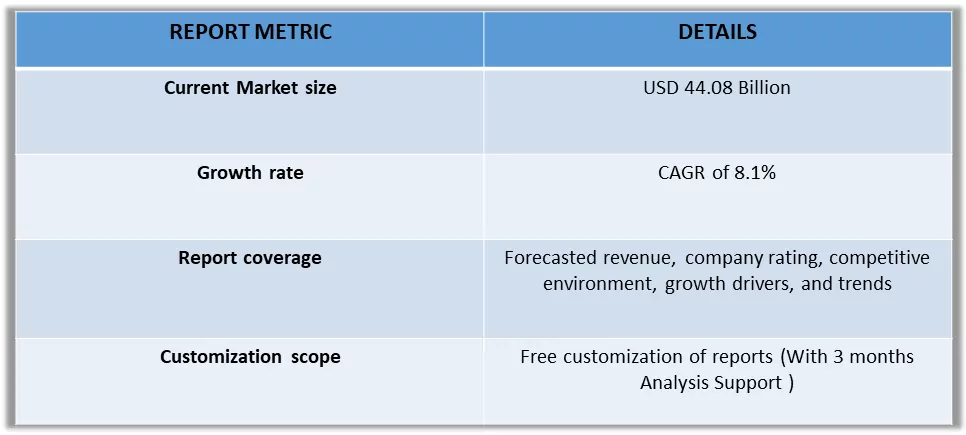The Flowers and Ornamental Plants Market is currently valued at USD 44.08 billion and is expected to grow at a CAGR of 8.1% over the forecast period, 2024-2031.

Get Complete Analysis Of The Report- Download Free Sample PDF
The global flower and ornamental plants market is characterized by a vibrant and dynamic landscape driven by diverse consumer preferences, seasonal trends, and the growing significance of aesthetics in various sectors. As an integral part of the horticulture industry, the market encompasses a wide array of floral varieties and ornamental plants, catering to both residential and commercial purposes. The demand for flowers and ornamental plants is influenced by factors such as cultural traditions, landscaping trends, and the rising popularity of green spaces. In recent years, there has been an increased emphasis on sustainable and eco-friendly practices, shaping the market towards organic and locally sourced options. The market is also impacted by the ebb and flow of seasonal demand, with events like weddings, festivals, and celebrations driving spikes in sales.
Additionally, the online retailing of flowers and ornamental plants has gained traction, offering consumers a convenient way to access a diverse range of botanical products. The market's growth is underpinned by continuous innovation in breeding techniques, the introduction of novel varieties, and a focus on enhancing the longevity and visual appeal of flowers, reflecting the evolving preferences of consumers worldwide. The growth of the global flower and ornamental plants market is propelled by several key factors. Firstly, the increasing consumer inclination towards beautifying indoor and outdoor spaces, driven by a growing awareness of the positive impact of greenery on well-being, is a significant growth driver. Additionally, the rising trend of gifting flowers on various occasions, coupled with cultural practices that involve the use of ornamental plants in celebrations, contributes to market expansion. Moreover, the expanding availability of a wide variety of flowers and ornamental plants through online platforms has enhanced accessibility for consumers, boosting market demand. Furthermore, advancements in breeding technologies and cultivation practices, leading to the introduction of new and exotic varieties with enhanced durability and aesthetics, are fostering market growth. The emphasis on sustainability and eco-friendly choices is also influencing consumer preferences, driving the demand for responsibly sourced and locally produced flowers and ornamental plants. Overall, the market's growth is underpinned by a combination of lifestyle trends, cultural practices, technological advancements, and a growing appreciation for the aesthetic and psychological benefits of floral and ornamental greenery.
Market Segmentation: The global flowers and ornamental plants market is Segmented by Product Type (Cut Flowers, Potted Plants, Bedding Plants, and Flowering Bulbs), End Users (Residential, Commercial and Gifts) and Geography (North America, Europe, Asia-Pacific, Latin America, Middle East & Africa). The market size and forecasts are provided in terms of value (in USD million) for all the above segments.

For Detailed Market Segmentation - Download Free Sample PDF
The global flower and ornamental plants market is witnessing several notable trends that shape its dynamics. One prominent trend is the increasing popularity of sustainable and eco-friendly practices throughout the floral industry. Consumers are placing a higher emphasis on responsibly sourced flowers and ornamental plants, driving a shift towards eco-conscious cultivation and distribution methods. Another key trend is the rise of online platforms for purchasing flowers and ornamental plants, offering consumers a convenient and extensive array of choices. E-commerce channels provide a platform for growers and sellers to reach a wider audience, fostering global market connectivity. Additionally, there is a growing demand for unique and exotic varieties, with consumers seeking plants that serve both aesthetic and functional purposes. The integration of technology, such as augmented reality (AR) and virtual reality (VR), for online plant shopping experiences is also emerging as a trend, providing customers with immersive and informative interactions. Furthermore, the market is witnessing a surge in the popularity of indoor plants, driven by the increasing awareness of their air-purifying qualities and their ability to enhance interior aesthetics. Overall, the global flower and ornamental plants market is evolving in response to changing consumer preferences, sustainability concerns, and advancements in technology.
Market Drivers:
Growing Consumer Interest in Home Gardening
The increasing trend of home gardening and landscaping projects is a major driver for the market. As more consumers engage in gardening activities, there is a rising demand for a variety of flowers and ornamental plants to enhance the aesthetic appeal of residential spaces. This trend is fueled by factors such as a desire for personalized outdoor spaces, the therapeutic benefits of gardening, and the increasing focus on home improvement.
Rising Demand for Sustainable and Locally Sourced Products
Consumers are becoming more environmentally conscious and are actively seeking sustainably produced and locally sourced flowers and ornamental plants. This demand is driven by concerns about the environmental impact of the floral industry, including transportation emissions and the use of pesticides. As a result, there is a growing preference for flowers and plants that are cultivated using eco-friendly practices, contributing to the rise of sustainable and locally focused supply chains in the market.
Market Restraints:
One notable market restraint for the global flower and ornamental plants market is the susceptibility to seasonal and climatic variations. The industry is highly dependent on weather conditions, which can significantly impact the cultivation, quality, and availability of flowers and ornamental plants. Adverse weather events, such as unseasonal frosts, extreme temperatures, or unexpected storms, can disrupt growing cycles, leading to supply shortages and affecting product quality. Additionally, climatic changes may influence consumer preferences and shift demand for certain types of flowers. This inherent vulnerability to environmental factors poses challenges for producers and suppliers, requiring them to implement adaptive strategies and invest in technologies to mitigate the risks associated with climate-related uncertainties.
The global flower and ornamental plants market experienced a notable impact from the COVID-19 pandemic. The lockdowns, travel restrictions, and disruptions in supply chains led to a series of challenges for the industry. With events like weddings, celebrations, and public gatherings being postponed or cancelled, the demand for flowers and ornamental plants, especially those used for decoration and gift purposes, witnessed a sharp decline. The closure of retail outlets and restrictions on floral exports further added to the strain on the market. However, the crisis also prompted a shift in consumer behaviour, with a growing interest in home gardening and a preference for outdoor spaces. As restrictions eased, the market showed signs of recovery, with a renewed emphasis on e-commerce platforms and contactless delivery. The industry adapted to the changing landscape by implementing safety measures, reevaluating supply chains, and exploring innovative ways to connect with consumers in the "new normal."
Segmental Analysis:
Bedding Plants Segment is Expected to Witness Significant Growth Over the Forecast Period
The use of bedding plants is growing steadily, driven by several factors. Firstly, bedding plants are popular among gardeners and landscapers for their ability to quickly and easily add color and texture to outdoor spaces. These plants are often used to create vibrant flower beds, borders, and containers, enhancing the aesthetic appeal of gardens, parks, and public spaces. Secondly, the increasing trend towards urban gardening and small-space gardening has contributed to the popularity of bedding plants. These plants are well-suited for balconies, patios, and small yards, allowing urban dwellers to create beautiful garden spaces in limited areas. Furthermore, the availability of a wide variety of bedding plants, including annuals and perennials, with different colors, sizes, and bloom times, has made them a popular choice for gardeners looking to create diverse and visually appealing landscapes. Additionally, bedding plants are relatively easy to grow and maintain, making them accessible to novice gardeners and those with limited gardening experience. This ease of cultivation, coupled with their decorative value, has contributed to the growing use of bedding plants in landscaping and gardening projects around the world.
Commercial Segment is Expected to Witness Significant Growth Over the Forecast Period
The commercial use of flowers and ornamental plants is experiencing a notable increase, driven by several factors. Firstly, the growing trend of incorporating green spaces and biophilic elements in commercial environments, such as offices, hotels, and retail spaces, has led to a higher demand for flowers and plants for interior landscaping. These plants not only enhance the aesthetics of the space but also contribute to a healthier and more pleasant environment for occupants. Secondly, the use of flowers and ornamental plants in event decoration and landscaping has also witnessed significant growth. Flowers are often used in weddings, corporate events, and other special occasions to create visually stunning arrangements and decorations. Additionally, landscapers and designers are increasingly using ornamental plants to create beautiful outdoor spaces in commercial settings, such as parks, shopping centers, and public gardens. Furthermore, the rise of e-commerce has made it easier for businesses to access a wide variety of flowers and ornamental plants from around the world. This has led to an increase in the availability of exotic and unique plant species for commercial use, further driving the demand for these plants in the commercial sector. Thus, the growing commercial use of flowers and ornamental plants is a result of their ability to enhance the visual appeal of spaces, improve air quality, and create inviting and welcoming environments for customers, visitors, and employees alike.
North America Region is Expected to Witness Significant Growth Over the Forecast Period
In North America, the use of flowers and ornamental plants is widespread and deeply rooted in the region's culture and landscaping practices. One of the primary uses of flowers and ornamental plants in North America is for landscaping purposes. Residential and commercial properties alike often feature gardens, flower beds, and landscaping designs that incorporate a variety of flowers and ornamental plants to enhance the aesthetic appeal of the surroundings. In addition to landscaping, flowers and ornamental plants are also used extensively in North America for interior decoration. Indoor plants are popular in homes, offices, and public spaces, not only for their decorative value but also for their ability to improve air quality and create a more pleasant environment. Moreover, flowers play a significant role in cultural and social events in North America. They are commonly used in weddings, funerals, and other special occasions to convey emotions and sentiments. The floral industry in North America is well-developed, with florists and flower shops offering a wide range of flowers and arrangements to meet the diverse needs of consumers. Thus, the use of flowers and ornamental plants in North America is multifaceted, encompassing landscaping, interior decoration, and cultural traditions. Their presence adds beauty, color, and life to the region's urban and rural landscapes, contributing to the overall quality of life in North America.

Get Complete Analysis Of The Report- Download Free Sample PDF
The analyzed market exhibits a high degree of fragmentation, primarily attributable to the presence of numerous players operating on both a global and regional scale. The competitive landscape is characterized by a diverse array of companies, each contributing to the overall market dynamics. This fragmentation arises from the existence of specialized solution providers, established industry players, and emerging entrants, all vying for market share. The diversity in market participants is underscored by the adoption of various strategies aimed at expanding the company presence. On a global scale, companies within the studied market are strategically positioning themselves through aggressive expansion initiatives. This often involves entering new geographical regions, targeting untapped markets, and establishing a robust global footprint. The pursuit of global expansion is driven by the recognition of diverse market opportunities and the desire to capitalize on emerging trends and demands across different regions. Simultaneously, at the regional level, companies are tailoring their approaches to align with local market dynamics. Regional players are leveraging their understanding of specific market nuances, regulatory environments, and consumer preferences to gain a competitive edge. This regional focus allows companies to cater to the unique needs of local clientele, fostering stronger market penetration. To navigate the complexities of the fragmented market, companies are implementing a range of strategies. These strategies include investments in research and development to stay at the forefront of technological advancements, mergers and acquisitions to consolidate market share, strategic partnerships for synergies, and innovation to differentiate products and services. The adoption of such multifaceted strategies reflects the competitive nature of the market, with participants continually seeking avenues for growth and sustainability. In essence, the high fragmentation in the studied market not only signifies the diversity of players but also underscores the dynamism and competitiveness that drive ongoing strategic maneuvers. As companies explore various avenues for expansion, the market continues to evolve, presenting both challenges and opportunities for industry stakeholders.
Some of the major players operating in the flowers and ornamental plants market are:
Recent Developments:
1) In March 2022, MARGINPAR BV launched Clematis Amazing, with Sydney as its latest addition to the series. Clematis Amazing Sydney, grown on partner farms in Tanzania, boasts a length of 70 cm. This development marks a significant expansion of the company's product range.
2) In March 2022, Selecta Klemm introduced Pink Kisses, a remarkable breeding achievement, along with several other standalone varieties such as Peach Party, Purple Wedding, Scully, and the DiaDeur series. This move is aimed at diversifying the company's product portfolio and enhancing its market presence.
Q1. What is the current Flowers and Ornamental Market size?
As per Data Library Research the Flowers and Ornamental Plants Market is currently valued at USD 44.08 billion.
Q2. What is the Growth Rate of the Flowers and Ornamental Market ?
Flowers and Ornamental Market is expected to grow at a CAGR of 8.1% over the forecast period.
Q3. Which region has the largest share of the Flowers and Ornamental market? What are the largest region's market size and growth rate?
North America has the largest share of the market. For detailed insights on the largest region's market size and growth rate request a sample here.
Q4. What are the factors driving the Flowers and Ornamental market?
Key factors that are driving the growth include the Growing Consumer Interest in Home Gardening and Rising Demand for Sustainable and Locally Sourced Products.
Data Library Research are conducted by industry experts who offer insight on industry structure, market segmentations technology assessment and competitive landscape (CL), and penetration, as well as on emerging trends. Their analysis is based on primary interviews (~ 80%) and secondary research (~ 20%) as well as years of professional expertise in their respective industries. Adding to this, by analysing historical trends and current market positions, our analysts predict where the market will be headed for the next five years. Furthermore, the varying trends of segment & categories geographically presented are also studied and the estimated based on the primary & secondary research.
In this particular report from the supply side Data Library Research has conducted primary surveys (interviews) with the key level executives (VP, CEO’s, Marketing Director, Business Development Manager and SOFT) of the companies that active & prominent as well as the midsized organization
FIGURE 1: DLR RESEARH PROCESS

Extensive primary research was conducted to gain a deeper insight of the market and industry performance. The analysis is based on both primary and secondary research as well as years of professional expertise in the respective industries.
In addition to analysing current and historical trends, our analysts predict where the market is headed over the next five years.
It varies by segment for these categories geographically presented in the list of market tables. Speaking about this particular report we have conducted primary surveys (interviews) with the key level executives (VP, CEO’s, Marketing Director, Business Development Manager and many more) of the major players active in the market.
Secondary ResearchSecondary research was mainly used to collect and identify information useful for the extensive, technical, market-oriented, and Friend’s study of the Global Extra Neutral Alcohol. It was also used to obtain key information about major players, market classification and segmentation according to the industry trends, geographical markets, and developments related to the market and technology perspectives. For this study, analysts have gathered information from various credible sources, such as annual reports, sec filings, journals, white papers, SOFT presentations, and company web sites.
Market Size EstimationBoth, top-down and bottom-up approaches were used to estimate and validate the size of the Global market and to estimate the size of various other dependent submarkets in the overall Extra Neutral Alcohol. The key players in the market were identified through secondary research and their market contributions in the respective geographies were determined through primary and secondary research.
Forecast Model
